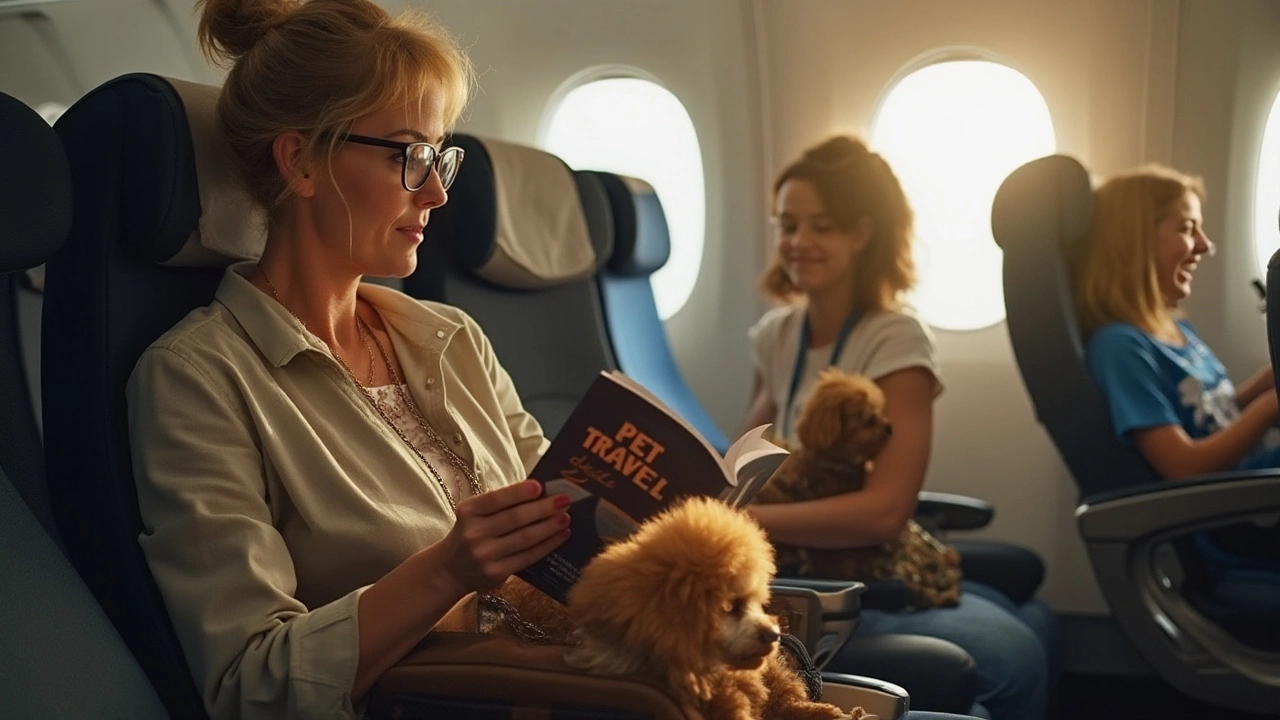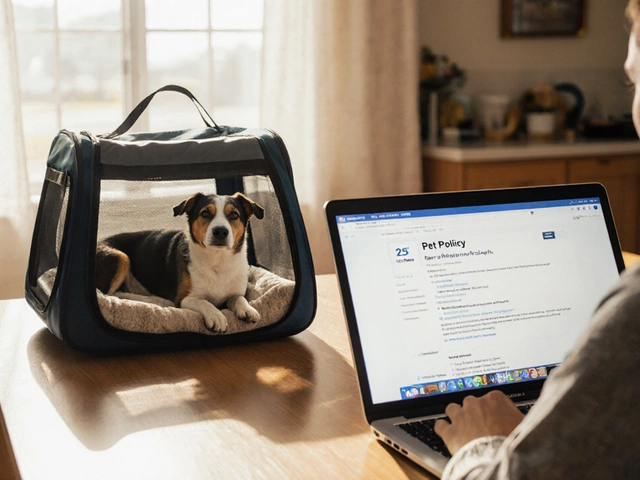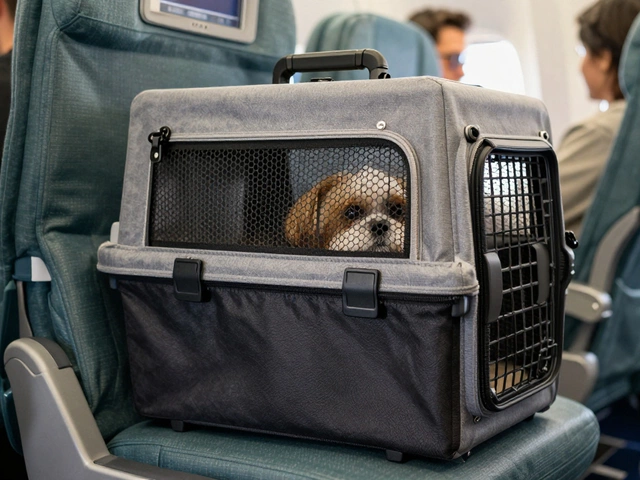Traveling with a dog can add a layer of joy to your journey, but it also comes with its own set of challenges. If you're thinking about bringing your furry friend on your next flight, you might be wondering whether you can buy them a seat right next to yours. While the rules vary from airline to airline, some offer options that could let your pup enjoy the cabin experience with you.
Before you pack your pet's travel bag, it's important to understand the different policies airlines have regarding in-cabin pet travel. Some carriers allow small dogs to travel in the cabin, provided they fit in an airline-approved carrier under the seat, while others may allow you to purchase a seat for your pet under certain conditions. Are you curious about the logistics and tips for ensuring both you and your dog have a smooth journey? Let's dive in and explore everything you need to know about flying with your canine companion on board.
- Understanding Pet Travel Policies
- Airlines That Allow Dogs in the Cabin
- Buying an Extra Seat for Your Dog
- Preparing Your Dog for Air Travel
- Tips for a Stress-Free Flight
- Alternatives to Flying with Your Dog
Understanding Pet Travel Policies
When it comes to flying with pets, especially dogs, an understanding of pet travel policies is essential for a hassle-free experience. Airlines often have a myriad of rules that can be difficult to navigate if you're not prepared, making it crucial to familiarize yourself with them ahead of time. Each airline has different guidelines about flying with dogs, largely determining your pet’s travel class, either in the cabin or cargo. Most US airlines like Delta and American Airlines allow small dogs in the cabin on select routes, provided they can fit comfortably in an approved carrier. Larger dogs usually need to travel in the cargo hold, which can be a daunting experience for pet owners.
These policies vary not only by airline but sometimes by aircraft and destination too. As airlines are committed to ensuring both human and animal safety during flights, they might impose restrictions based on aircraft type or international regulations. For instance, certain countries require quarantine periods for incoming dogs, complicating plans further. Moreover, during extreme weather conditions, airlines may restrict pets' travel, especially in cargo, to safeguard their well-being. Understanding these intricacies is vital.
"Always read the fine print and check with your airline a few days before the flight," advises Dr. Jessica Smith from Pet Travel Experts.
To simplify, you can break down the pet travel policies into a few common aspects across airlines. First, check the size and weight limitations for in-cabin travel. This generally includes your pet's carrier and can vary between airlines. Second, review the documentation required for your dog. This might include vaccination records and health certificates, especially for international travel. Third, know the cost upfront, as fees can add up. Domestic flights often have a pet fee ranging from $75 to $150 per segment. Lastly, understand special circumstances such as pandemic restrictions that might impact airline operations or pet acceptance policies.
Such thorough preparation is not just about avoiding last-minute surprises; it's about ensuring a smooth and pleasant journey for your canine companion. Remember, staying informed about each aspect of flying with dogs can transform what initially seems like a challenge into an enjoyable bonding experience with your dog. Pet travel has evolved, and by understanding the policies clearly, we can all take to the skies alongside our beloved furry friends.
Airlines That Allow Dogs in the Cabin
Deciding to fly with your dog can feel like an overwhelming choice due to the plethora of airline options and their varied pet travel policies. Each airline has its unique set of regulations and fees, which can either invite or deter you from bringing your furry pal onboard. Some major airlines that permit dogs in the cabin include Delta, American Airlines, and United. They offer passengers the opportunity to keep small-sized dogs close by, under their seats. The catch is that both the dog and the carrier need to meet strict weight and size requirements. Typically, this means your dog should not weigh more than 20 pounds while inside the carrier, and the measurements should fit under an airplane seat. This policy ensures that the animal does not disturb other passengers or block the aisle, which is paramount for safety reasons.
Each airline, of course, has its specific approach. Delta Air Lines, for example, allows passengers to bring small dogs, cats, and household birds on domestic flights. American Airlines follows a similar protocol but has additional stipulations regarding the age and health of the animal, along with adherence to vaccination records. United Airlines, on the other hand, offers a PetSafe program which is known for its additional assurances, including climate-controlled areas for pets. Astonishingly, some individuals might be surprised to learn that JetBlue champions pet travel, offering their customers a program called JetPaws. This program not only demonstrates the airline's support for pet ecstasy but also provides additional tips and provides a rewards system for frequent flying pets. Isn’t that fascinating?
When planning to purchase an extra seat for your dog, knowing these airline policies is key. Notably, while Southwest Airlines is among those allowing pets in the cabin, it does not permit purchasing a separate seat for them. Considering this information helps travelers in selecting the right airline that meets their requirements. A common pitfall travelers may encounter is assuming their furry friend can roam freely during the flight. This is far from reality as most airlines stipulate that your dog should remain within the carrier throughout.
"Flying with a pet is not just a service; it’s a commitment to comfort and safety," remarked a spokesperson from Delta Airlines. "We aim to make the journey as pleasant as possible for both our human and animal passengers alike."
When it comes to preparing for air travel with a dog, it’s also pivotal to consider each airline’s pet fees and booking policies well in advance, as some airlines limit the number of pets allowed in the cabin. Fees typically range between $95 to $125 each way and are non-refundable should you cancel or reschedule. British Airways, although a popular choice for international travel, only allows service animals in the cabin, opting instead for transporting pets as cargo. Hence, selecting an airline aligns with Figure 1, which provides a comparative overview of several airline pet policies.
| Airline | Cabin Pet Allowed | Pet Fee (One-Way) | Maximum Weight |
|---|---|---|---|
| Delta | Yes | $125 | 20 lbs |
| American Airlines | Yes | $125 | 20 lbs |
| JetBlue | Yes | $100 | 20 lbs |
| United Airlines | Yes | $125 | 20 lbs |
Summing up, getting your pet aboard a flight with you is attainable, provided you stick to the given guidelines. Always remember to check the specific regulations of the airline, as they can change or be updated. Armed with the right information, there is tremendous potential to make your air travel both convenient and enjoyable for you and your dog.
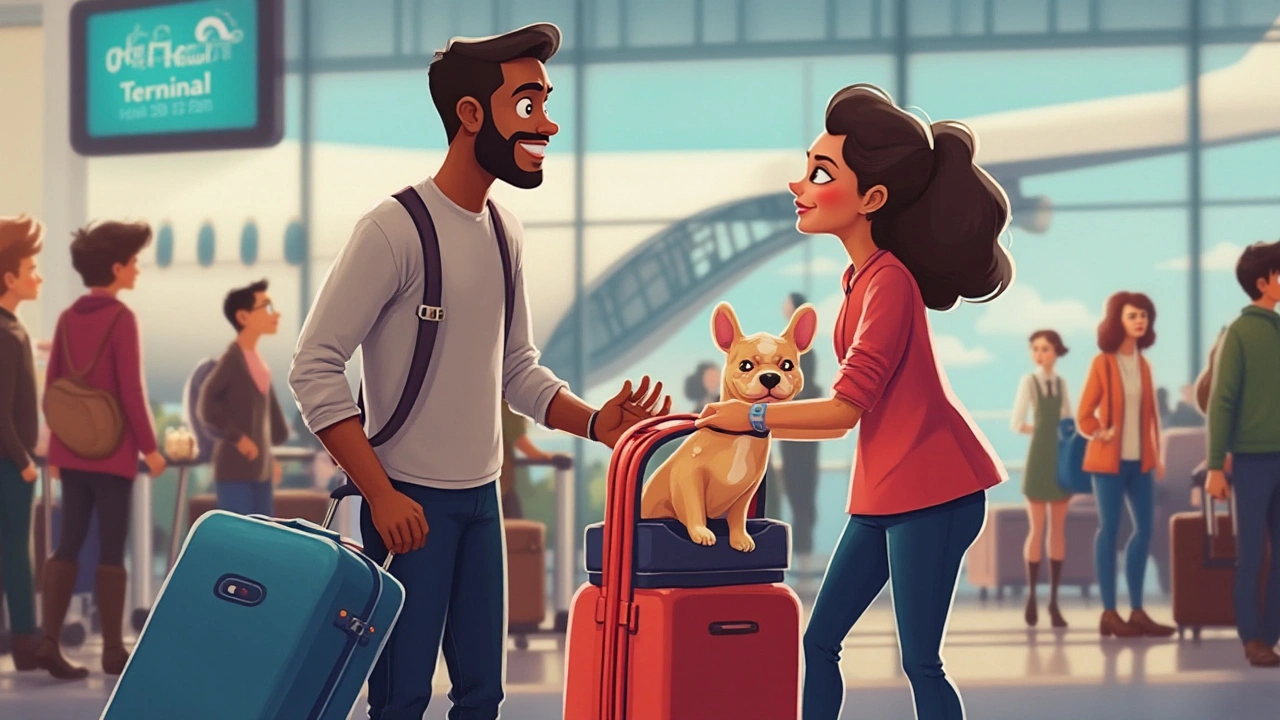
Buying an Extra Seat for Your Dog
When it comes to purchasing an extra seat for your beloved pup, the policies can be a bit tricky to navigate, largely because most airlines don't officially allow pets to occupy a seat. However, some creative maneuvering can occasionally make this possible, especially when you're armed with the right information. Many airlines have policies that facilitate in-cabin pet travel, but this typically involves your dog being in a carrier that fits under the seat in front of you. Nonetheless, if you’re traveling with a larger dog or seeking more legroom, you might consider purchasing an extra ticket for added space. It’s crucial to communicate with the airline directly to understand how they can accommodate your needs.
Some airlines that are pet-friendly may even permit larger dogs to be seated with you, depending on their weight and size, and if you adhere to specific regulations regarding carriers and flight logistics. Although many standard airlines like Delta, United, and American Airlines do not sell a dedicated seat for your dogcapably, they may offer two-seat arrangements to give you more personal room for you and your dog. It is wise to call the airline's customer service ahead of time to inquire about all viable options. One possibility that has been gaining popularity is flying on private jets, where more personalized arrangements are plausible, but these come at a luxury cost. Yet, for some affluent travelers, the comfort and reassurance are worth every penny.
Here’s an insightful statistic to mull over: According to a 2023 survey conducted by the International Pet and Animal Transportation Association (IPATA), pet travel inquiries had increased by approximately 20% annually over the previous five years. This trend indicates an increasing demand for accommodating pets during flights, which may potentially influence more flexible future policies. And, if you’re persistent and flexible with your travel dates and times, booking quieter flights where there might be an abundance of empty seats could work in your favor. The last thing you want is an embarrassed glance at your watch each time your dog becomes vocal during the flight.
"The secret to comfortable air travel with dogs starts with thorough research and finding unconventional solutions within the existing regulations," remarks Emily Connors, a leading travel consultant with over a decade of experience in pet travel. "Don't be afraid to ask questions and propose solutions that would work for both you and the airline."
Ultimately, while directly purchasing a seat for your furry friend isn't the norm for most commercial flights, with proper communication and planning, there may be ways to work around the system to ensure that both you and your dog have a more pleasant journey. Always consult with your chosen airline well in advance to explore all the options. And remember that flexibility and creativity in your approach to pet air travel can yield surprising results, allowing you to savor these adventures together without too much compromise on comfort.
Preparing Your Dog for Air Travel
When flying with your furry companion, preparation is key to ensuring a smooth journey. Taking your dog along on a flight is not just a case of strapping them in; it involves careful planning and consideration of several factors. Begin by getting your dog comfortable with their travel crate well in advance of your trip. This means introducing them to the crate as a familiar and positive space, filled with their favorite toys and a comfortable blanket. Gradually increase the time they spend in it, rewarding them with treats, so they see it as a cozy den rather than a confined space. Make sure the crate is the right size and meets the airline's specifications for in-cabin travel to avoid any hiccups at the airport.
The next step is to schedule a visit to the vet. Health checks are crucial to ensure your pup is fit to fly and up-to-date with all vaccinations, which some airlines may require proof of before boarding. Discuss any concerns you might have about your dog's comfort and stress levels during the flight with your vet. They might recommend mild sedatives or calming products if your dog gets particularly anxious. However, sedation is largely discouraged by many experts. According to the American Veterinary Medical Association, sedation can increase the risk of heart and respiratory issues during flight.
Preparing for the logistics of check-in and security also deserves your attention. On the day of travel, arrive at the airport early to allow extra time for the additional steps involved with pet travel. You will need to go through security screening with your dog, which sometimes involves taking them out of the carrier. Have some healthy, non-sedating snacks on hand to keep your dog occupied and calm. It's also wise to bring along collapsible bowls for water and food, making sure they are easily accessible without having to rummage through packed luggage.
Nourishment and hydration are other important aspects. Dogs, like humans, need to stay hydrated, especially in arid airplane air. However, avoid feeding your dog a large meal right before the flight, as this can lead to discomfort or motion sickness. Instead, offer a light meal a few hours before departure and small sips of water leading up to boarding. It’s a balance game – ensuring they are neither too full nor too thirsty during the flight.
"Preparation for pet travel encompasses both your pet's comfort and adhering to airline regulations," says Dana Crump, a seasoned veterinary travel consultant, emphasizing the importance of knowing airline procedures inside out.
Lastly, put together a small travel kit. This should include essential items like waste bags, a leash, any necessary medications, and documentation of vaccinations and health clearances. Having these at hand will save you from potential hassle and ensure you are ready to provide for your dog’s needs during the journey. Remember, the secret to stress-free air travel with your dog lies in their comfort and your readiness to handle any situation that might arise.
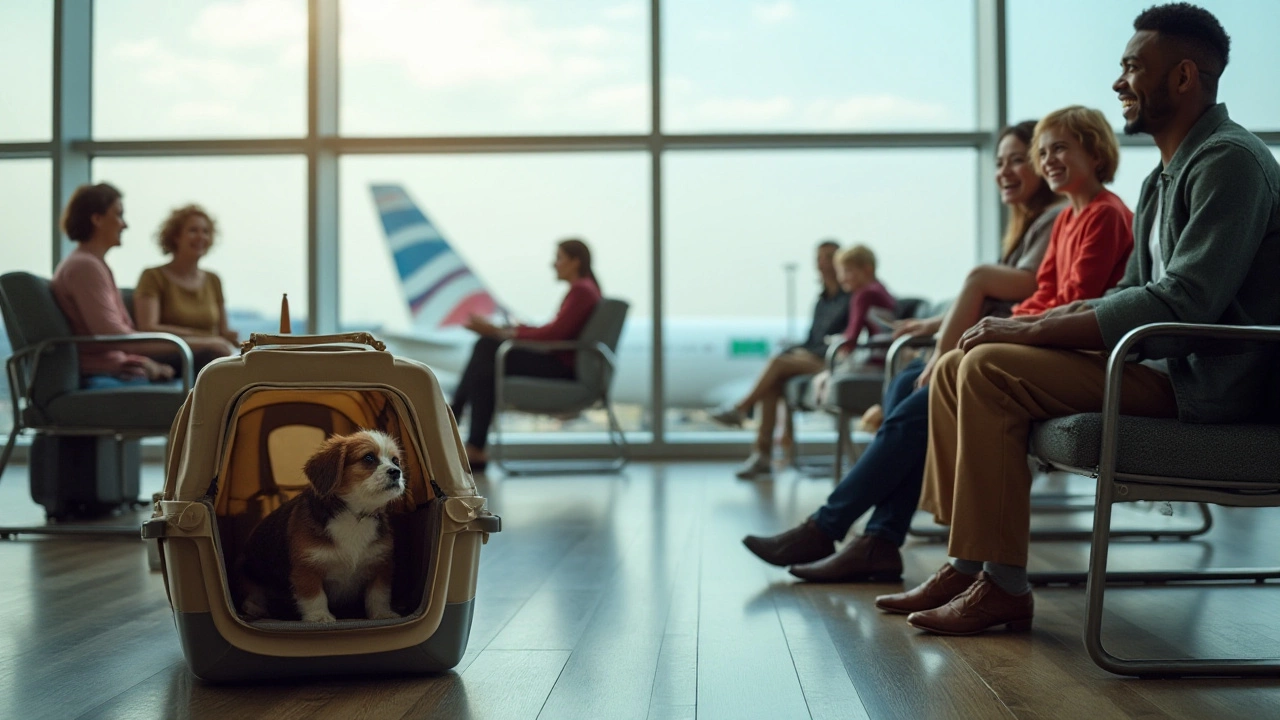
Tips for a Stress-Free Flight
Ensuring a smooth and stress-free flight for you and your dog requires some thoughtful planning. The first step is to make your journey pet-friendly by choosing an airline that accommodates your dog's specific needs. You'll want to confirm with the airline about their pet policies, especially regarding cabin travel, and ensure your furry friend meets their size and weight requirements. Once travel is confirmed, it's crucial to schedule your flight during a calm time of day, usually early morning or late evening. These flights tend to be less crowded and more convenient for pets who might be nervous around large crowds.
Prepare your dog for the journey by getting them accustomed to their travel crate or carrier well in advance of your departure date. Training your dog to see the crate as a safe and comfortable space can alleviate anxiety on the actual day of the flight. One effective way is to gradually introduce your dog to the carrier, starting with short stays inside in a relaxed setting. Over time, increase the duration until they are comfortable being in the crate for a few hours. For in-cabin travel, ensure the crate fits snugly under the seat and meets all airline specifications.
Offering familiar toys or bedding in the crate can provide a sense of comfort and familiarity for your pup. Additionally, ensure your pet is sufficiently exercised before the flight. A long walk or an active play session will help expend excess energy, making your dog more likely to rest during the flight. Some pet owners also consult with their veterinarians about using herbal supplements or mild sedatives for particularly anxious dogs; however, this should be done with caution and under professional guidance.
"Pets traveling by air can experience stress levels similar to humans. Ensuring they have familiar scents or items can significantly reduce anxiety," advises Dr. Sarah Evans, a renowned veterinarian specializing in pet travel care.
On the day of the flight, arrive at the airport early to allow extra time for check-in and security procedures. This extra time reduces stress for both you and your pet and gives your dog a chance to acclimate to the airport environment. Remember to pack a travel kit for your dog, including essentials like a leash, collapsible bowl, a small bag of their usual food, and any necessary medications. Hydration is key, so keep a bottle of water handy.
During the flight, it's beneficial to occasionally check on your pet. If the airline allows, open the carrier enough to offer a treat or reassuring pat. Maintain a calm demeanor, as dogs often take cues from their owners. Keep an eye on the signs your pet might be uncomfortable, such as whining or scratching, and adjust accordingly. Upon arrival, take a moment before rushing off to your next destination to let your dog stretch its legs, ideally in a designated pet relief area within the airport.
Alternatives to Flying with Your Dog
For those who have weighed the pros and cons of flying with their beloved canine and decided it may not be the best option, there are several alternatives to consider. Pet travel doesn’t always have to mean going by air. Depending on the distance and destination, other modes of transport might not only be more economical but also less stressful for both you and your four-legged companion. Exploring these options might just open up an enjoyable adventure, where both of you can enjoy the journey and the destination.
One popular alternative is to embark on a road trip. Traveling by car gives your dog the comfort of familiar surroundings and allows for flexible pet breaks. Whether you’re driving along a coastal highway or navigating scenic country roads, driving gives you the freedom to plan your own itinerary. This means more time for those much-loved doggy pit stops, where you can stretch your legs and your pup can explore the new scents and sights. If you're considering this option, make sure the vehicle is set up for safe and comfortable travel with your pet, using car seat barriers or harnesses specifically designed for dogs.
Another option might be rail travel, which some pet owners find incredibly convenient. Certain train services allow pets to travel alongside their owners in specified areas or cabins. For example, Amtrak in the United States now permits dogs under a specific weight limit on many of its routes, provided they remain in a carrier. This offers a unique and sometimes scenic way to reach your destination. Have you ever thought of cruising via train to a new city with your furry friend by your side, watching landscapes roll past?
"Traveling by train with your pet can truly transform your journey. It's like stepping back in time, with all the comforts of modern travel," according to Danielle Williams, a travel consultant specialized in pet-friendly journeys.
For international travel where flights seem unavoidable, using a pet shipping service might be an alternative worth considering. These specialized companies handle everything from documentation to transport logistics. They can ensure that your pet arrives safely, often in a more spacious and comfortable section of the plane than what is available in the cabin. This can remove a lot of the stress and worry associated with international flying with dogs.
If neither of these suits or situations dictate it's best your pet stays behind, hiring a reliable pet sitter or lodging them at a reputable kennel is another choice. The familiarity of home or professional pet care can provide a tranquil environment while you're away. Many pet sitters offer daily updates and photos, providing peace of mind that your furry friend is receiving the best care. Deciding what suits your pup best depends on their temperament and needs, along with what makes you feel most comfortable. Options abound, and finding the right one could turn your next trip into an unforgettable experience for both.
